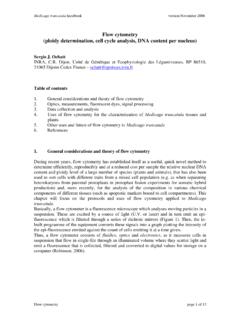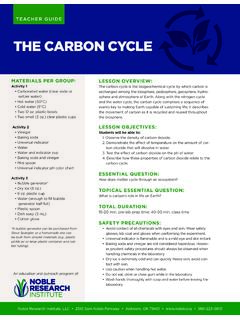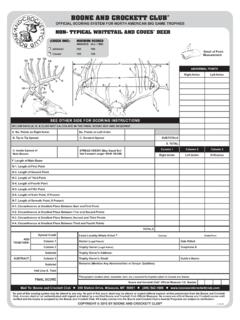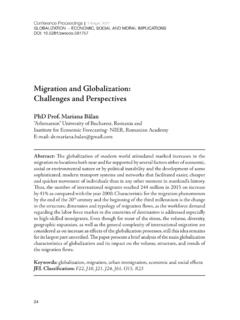Transcription of White-tailed Deer Antler Score: A Pictorial Presentation
1 IntroductionFrom a hunting and economic perspec-tive, White-tailed deer, Odocoileus vir-ginianus, is the most important wildlife species in the eastern half of the More landowners and hunters in this region are interested in White-tailed deer than in any other wildlife species. More income is generated for eastern, central and southern state wildlife departments and landowners through White-tailed deer hunting than is gener-ated by any other wildlife species. Many, if not most, deer hunters and deer managers want to harvest bucks with large antlers.
2 Antler size and corresponding Antler score typically increase as a buck ages. In many areas, buck age is the factor that most limits Antler size of male White-tailed deer even though nutrition and genetics also play important roles. Most bucks must be allowed to live several years to have the opportunity to achieve moderate to large Antler size. Several strategies are utilized to limit buck harvest and increase buck survival, such as property buck harvest limits, hunter buck harvest limits, hunter education, doe hunting emphasis, doe harvest requirement before harvesting a buck, and shoul-der mount requirement when a buck is harvested.
3 Successful programs usually incorporate several deer harvest management programs on private properties allow hunters to harvest bucks only when their antlers score above certain thresholds, which encourages hunt-ers to be more selective and pass up small-antlered bucks. For such ap-proaches to be successful, hunters and deer managers need to be able to judge or estimate Antler scores when viewing bucks in the field. By studying the photos and associated parameters in this publication, many readers can improve their ability to estimate Antler scores of bucks in the field.
4 Bucks in this publication were har-vested in Oklahoma and are organized by gross Antler score from lower to higher. We attempt to show the pho-tos at a 1:8 scale (1 inch in a photo on an x 11-inch page represents approximately 8 inches actual size), so apparent differences in Antler size can represent actual differences; however, each photo has depth and angle dis-tortions that limit accurate correlation. When available, the following informa-tion is provided for each buck: photos depicting front and side views of head with antlers, gross and net Boone and Crockett scores, number of points, inside and outside spreads, main beam lengths, Antler circumferences, point lengths and dressed weight.
5 In this publication, Antler score re-fers to Boone and Crockett score. The Boone and Crockett scoring system ( ) is the most widely used and accepted scoring system for big game such as White-tailed deer. Several Antler score record and award programs such as Pope and Young Records, Cy Curtis Awards, Texas Big Game Awards, Magnolia Records, Outstanding White-tailed Deer, etc., use this scoring system. Boone and Crockett White-tailed deer Antler score represents a sum of Antler lengths, point lengths, circumferences and inside spread measured in inches to the nearest typical Boone and Crockett score includes deductions for asym-metry and non-typical points (Figure 1).
6 Net non-typical Boone and Crock-ett score adds the collective length of non-typical points to the net typical score (Figure 2). The typical tine ar-rangement arises from the top of the main beams. Non-typical points origi-nate from other locations such as other points, the sides or bottoms of the main beams, or between typical Boone and Crockett Club typi-cally does not utilize or record gross score. However, many hunters and sev-eral other programs use and refer to gross Antler score. In this publication, gross Antler score is the net typical Boone and Crockett score plus de-ductions (sum of column 3 on Figure 1) and the sum of non-typical point lengths, or the net non- typical score plus deductions.
7 To be a point, a projection must be at least 1 inch long and must be longer than its broadest width at least 1 inch from the tip (Figure 3). Length of a point is measured along the outside center of a point between its tip and base. The base of a point is the loca-tion where the normal surface of the main beam or other point would occur without the point. Inside spread is the widest space between the Antler beams perpendicular to the center line of the skull and parallel to the skull cap (measurement D in Figures 1 and 2). Basal circumference is the smallest circumference measurement between the burr and the first typical point, and is referred to as H1 on the Boone and Crockett score sheets (Figures 1 and 2).
8 Three additional circumferences are measured on each Antler , which are referred to as H2, H3 and H4 on the Boone and Crockett score sheets (Figures 1 and 2). The burr is a ridge at the base of an Antler just above the location where an Antler attaches to the frontal bone. The first typical point (also called a brow tine) on an Antler is referred to as G1 on the Boone and Crockett score sheets (Figures 1 and 2); however, it is not always present. Successive typical points are referred to as G2, G3, etc., on the Boone and Crockett score sheets (Figures 1 and 2).
9 NF-WF-14-02 The Samuel Roberts Noble Foundation4 White-tailed Deer Antler Score: A Pictorial PresentationMichael D. Porter Wildlife and Fisheries ConsultantAgricultural DivisionSamuel Roberts Noble FoundationArdmore, Oklahoma 73401 Kenneth L. GeeConservation Delivery SpecialistOaks and Prairies Joint Venture6438 Gene Autry RoadArdmore, Oklahoma 73401 WILDLIFEThe Samuel Roberts Noble Foundation22 Main beam length (measurement F in Figures 1 and 2) is measured along the outside centerline of an Antler from the middle lower edge of the burr to the distal tip of the main beam (Figures 1 and 2).
10 Dressed weight is measured in pounds after removal of abdominal and thoracic viscera and sex scores in this publication are green scores (measured before the required Boone and Crockett 60-day drying period). Green scores can be slightly higher than scores for the same antlers measured after the 60-day dry-ing period; nevertheless, green scores should accurately reflect the antlers seen in photographs of recently har-vested bucks. Green scores are indi-cated with an information is published as a digital, online publication so the au-thors can update or revise the publica-tion Samuel Roberts Noble Foundation3 The Samuel Roberts Noble FoundationSubmit completed score chart and check list items along with payment information to:BOONE AND CROCKETT CLUB250 STATION DRIVE, MISSOULA, MT 59801 TROPHY ENTRY CHECK LISTTROPHY ENTRY CHECK LIST Original score chart signed and dated by the Official Measurer.









